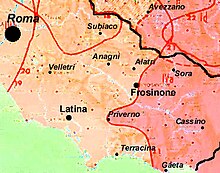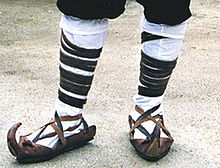Ciociaria
The Ciociaria is a landscape in central Italy east of Rome .
geography

The area of the Ciociaria cannot be clearly delimited. Traditionally, the mountainous region south and north of the Sacco Valley is called Ciociaria, i.e. the Monti Ernici , Monti Lepini and Monti Ausoni . Historically, it was the part of the district of the Papal State of Campagna e Marittima that lies east of the Aniene River and the Alban Hills . Today the Ciociaria is often equated with the province of Frosinone , although the eastern part of the province, which was added by the former Kingdom of Naples in 1927 , differs significantly in culture and dialect. In some cases, the neighboring mountain landscapes of the provinces of Latina and Rome are also included.
The Ciociaria was one of the poorest regions in Italy until the Second World War. When the Allies advanced on Rome in 1944 (see also: Battle of Monte Cassino ), the region suffered severe war damage. Up until the 1960s, many residents emigrated to major cities in northern Italy or to northern Europe and America. However, with the industrialization of the Sacco Valley and the construction of the Autostrada del Sole A1 from Rome to Naples in 1962, the standard of living was greatly increased.
dialect
In the core area of Ciociaria, the Saccotal and the Monti Lepini, an independent dialect, the Ciociaresco, is spoken. The population is proud of their dialect and therefore still uses it today. The Ciociaresco is one of the Central Italian dialects. In contrast, a southern Italian dialect is spoken in the eastern half of the province of Frosinone.
origin of the name
Ciociaria can be roughly translated as sandals land . The name derives from the Ciòcie , the traditional sandals of the shepherds of the mountainous region, tied with leather straps on the lower leg, which, however, were widespread throughout central Italy. He should probably allude to the poverty of the population.
tourism
Although the Ciociaria has spectacular landscapes, traditional culture and numerous art treasures, tourism is not developed there. In this respect, it stands in the shadow of Rome. The biggest attraction is the famous spa town of Fiuggi with its thermal springs. Alatri , Anagni , Ferentino and Veroli are particularly interesting historical cityscapes . Important monasteries in this area are Casamari , Fossanova and the Certosa di Trisulti .
Typical products
The Ciociaria is a wine-growing area that has gained in importance in recent years. Well-known wines are the Cesanese del Piglio , the Cabernet di Atina and the Sanmichele di Arce . The production of olive oil also plays a major role. The area around Amaseno is known for the buffalo mozzarella . Another typical cheese is the Marzolina .
Adaptation in the film
The mountain landscape of the Ciociaria has been chosen time and again as a location for films.
- And yet they live (La Ciociara) by Vittorio de Sica (1960) with Sophia Loren dealing with the chaos of war in 1944.
- Love, Bread and Fantasy (Pane, amore e fantasia) by Luigi Comencini (1953) with Gina Lollobrigida is set in the post-war period.
- The cross-eyed saint (Per grazia ricevuta) by and with Nino Manfredi (1971) is about popular belief.
Others
The asteroid (21799) Ciociaria is named after the landscape .
literature
- Christof Henning, DuMont Art Guide Latium , 2006, 3rd edition, ISBN 3-7701-6031-2
swell
- ↑ Maps of Pellegrini ( Memento of the original from October 12, 2009 in the Internet Archive ) Info: The archive link was automatically inserted and not yet checked. Please check the original and archive link according to the instructions and then remove this notice.
Web links
- Page about the Ciociaria (Italian)
- Tourism portal (Italian)
- Tourism portal (Italian, English)


